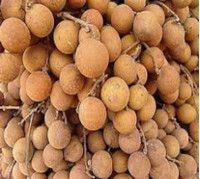Formulation, Physical Quality, and Microbial Contamination Tests of Anti-Acne Cream from Longan (Euphoria longan [Lour. Steud.]) Seed Extract http://www.doi.org/10.26538/tjnpr/v7i7.5
Main Article Content
Abstract
Acne is commonly associated with Propionibacterium acnes, a bacterium that can be treated by giving out anti-acne medications. These medications' anti-acne effects are derived from natural plant chemicals, like those in the seeds of longan (Euphoria longan [Lour. Steud.]) fruits. Longan seed extract needs to be made into a cream dosage form before it can be utilized as an anti-acne
treatment. Therefore, the present study was aimed at formulating longan seed extract cream with an anti-acne activity that meets the stability requirements of physical quality and microbial contamination tests. The longan seeds were extracted. Cream preparations with vanishing cream bases were formulated and evaluated for their anti-acne activity, physical stability, and microbial
contamination. The antibacterial effect was tested, while minimum inhibitory and minimum bactericidal concentration analyses were done using the broth dilution method. The results showed that the extract at a concentration of 1% had bacteriostatic effect, while extracts at concentrations of 2, 4, and 8% showed bactericidal activity. All cream formulas showed anti-acne activity and
met the requirements for microbial contamination testing. In terms of physical stability, all formulations met the standards. However, formulas I, II, and III did not meet the requirements of the pH test, while formulas V and VI did not meet the requirements of the spreadability test. The findings of this study reveal that the extract of longan seed provided inhibitory activity against Propionibacterium acnes, and the formula IV qualified for physical quality and microbial contamination tests, making it an effective anti-acne cream.
Downloads
Article Details

This work is licensed under a Creative Commons Attribution-NonCommercial-NoDerivatives 4.0 International License.
References
Tranggono, Iswari R, Latifah F. Buku Pegangan Ilmu Pengetahuan Kosmetik. PT. Gramedia Pustaka; 2007.
Sukandar EY, Retnosari A, Sigit JI, Adnyana IK, Setiadi, AP AA. ISO Farmakoterapi 2. Penerbit ISFI; 2011.
Salasa, A.M., Ratnah S. Determination of Total Phenolic Content (TPC) and Antioxidant Avtivity of Longan (Euphoria longan) Seed and Peel Extract. In: Interproprofessional Proceedings Collaboration on Urban Health Vol. 2. No.1. Politeknik Kesehatan Makassar; 2019.
Sapan, M.V., Salasa, A.M. Ratnah S. Uji Aktivitas Antibakteri Biji Buah Kelengkeng (Euphoria longan Stend) Terhadap Pertumbuhan Propionibacterium acnes.; 2018.
Dirjen Kefarmasian dan Alat Kesehatan. FarmakopeIndonesia. VI. Kementerian Kesehatan RI; 2020.
Litbang BB. Pedoman Umum Panen Dan Pascapanen Tanaman Obat. Kemenkes RI; 2011.
Egbuna C, Ifemeje JC, Udedi SC, Kumar S. Phytochemistry, Volume 1: Fundamentals, Modern Techniques, and Applications. Vol 1. Apple Academic Press Inc.; 2019.
Lay BW. Analisis Mikroba Di Laboratorium. PT. Raja Grapindo Persada, Jakarta; 1994.
Ratnah S, Salasa AM. Quality Standardization of Longan Seed Extract (Euphoria longan Stend). Int J Curr Pharm Res. 2022;14(2):31-35. doi:10.22159/ijcpr.2022v14i2.1948
Ditjen POM. Parameter Standar Umum Ekstrak Tumbuhan Obat. 1st ed. Depkes RI; 2000.
Karoll KC, Morse SA, Mietzner T, Miller S. Jawetz, Melnick Dan Adelberg’s Mikrobiologi Kedokteran. 27th ed. Buku Kedokteran EGC; 2017.
Davis WW, Stout TR. Disc plate method of microbiological antibiotic assay. I. Factors influencing variability and error. Appl Microbiol. 1971;22(4):659-665. doi:10.1128/aem.22.4.659-665.1971
Cappucino JG, Sherman N. Manual Laboratorium Mikrobiologi. 8th ed. Buku Kedokteran EGC; 2014.
Pratiwi ST. Mikrobiologi Farmasi. Erlangga; 2008.
Ratnah S, Salasa AM. Efektivitas Ekstrak Biji Buah Kelengkeng (Euphoria longan Stend) Terhadap Pertumbuhan Staphylococcus aureus dan Propionibacterium acnes.Media Farm. 2020;16(1).
Lachman L, Lieberman HA, Kanig JL. The Theory and Practice of Industrial Pharmacy. Third. Varghese Publishing House; 1987.
SNI. Sediaan Tabir Surya. Vol 16.; 1996.
Tranggono RI, Latifah F. Buku Pegangan Ilmu Kosmetik. (Djayadisastra J, ed.). PT. Gramedia Pustaka Utama; 2007.
Noviardi H, Ratnasari D, Fermadianto M. Formulasi Sediaan Krim Tabir Surya dari Ekstrak Etanol Buah Bisbul (Diospyros blancoi). J Ilmu Kefarmasian Indones.2019;17(2):262. doi:10.35814/jifi.v17i2.771
Purwaningsih, Septiarini AD, Wardani TS. Analisis Nilai SPF (Sun Protection Factor) Sediaan Krim Tabir Surya Ekstrak Etanol Bunga Pepaya Jantan (Carica papaya L.)Dengan Metode Spektrofotometri UV-Vis. J Farm PolitekIndonusa Surakarta. 2021;5(2):26-32.
Garg A, Aggarwal D, Garg S, Singla AK. Spreading of semisolid formulations: An update. Pharm Technol North Am.2002;26(9):84-105.
Arbie S, Sugihartini N, Wahyuningsih I. Formulasi Krim M/A Dengan Variasi Konsentrasi Ekstrak Buah Pepaya (Carica papaya L.) Menggunakan Emulgator Asam StearatDan Trietanolamin. Media Farm. 2021;16(1):97. doi:10.32382/mf.v16i1.1420
Sriamornsak P, Polat A, Krongrawa W, Krüger-genge A, Storsberg J, Seidler T. Formulation of MicroemulsionsContaining Rambutan Peel Extract and Their AntibacterialActivities.Trop J Nat Prod Res. 2023;7(April):2730-2736.
de Canha MN, Komarnytsky S, Langhansova L, Lall N. Exploring the Anti-Acne Potential of Impepho [Helichrysum odoratissimum(L.) Sweet] to Combat Cutibacterium acnesVirulence. Front Pharmacol. 2020;10(January):1-21.doi:10.3389/fphar.2019.01559
Dwiani S, Choirunnisa AR, Haniffadli A, et al. Reduction ofMicrobial Contamination in Kaolin from Belitung Island, Indonesia. Trop J Nat Prod Res. 2023;7(1):2104-2106. doi:10.26538/tjnpr/v7i1.3
Peraturan BPOM RI No. 32. Persyaratan Keamanan dan mutu Obat Tradisional. Bpom RI. Published online 2019.


